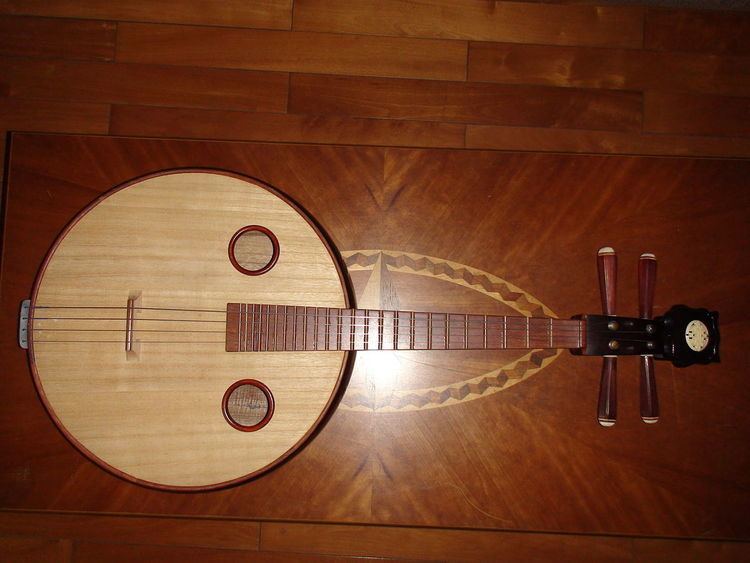 | ||
Classification Plucked string instrumentRuan Inventor(s) Chinese musical instrument | ||
The zhongruan (Chinese: 中阮; pinyin: zhōngruǎn; literally: "tenor ruan"), is a Chinese plucked string instrument. The zhongruan has a straight neck with 24 frets on the fingerboard and 4 strings. It is usually played with a plectrum (guitar pick). It can also be played with fingers (index finger and thumb with acrylic nails), which is similar to the way of playing the pipa (琵琶). The zhongruan is a tenor-ranged instrument in the family of ruan (阮). In ancient China, the ruan was called Qin pipa (Qin [Dynasty] pipa, 秦琵琶) or Ruan xian (阮咸). Now the ruan has expanded to different sizes and the zhongruan is the "medium" one.
Contents
Use
The default tuning of zhongruan is G2-D3-G3-D4. It can also be tuned as G2-D3-A3-E4, A2-D3-D3-D4, and other variants, according to requirements in music scores. Since the zhongruan has a rounded, calm and rich tone, it is usually played as a lead instrument in small ensembles and used to accompany other instruments in Chinese orchestra. It can also be played solo.
Construction
A good quality zhongruan is usually made of rosewood (紅木). For the best sound quality and visual appearance, it is made of red sandalwood (紫檀木), because red sandalwood is best known for its beautiful wood grain, unique purplish color, hardness and rareness. Therefore, a red sandalwood made zhongruan is heavier and more expensive.
The lute head (琴頭) is for decoration. Three common decorative patterns are ruyi (如意, good fortune), peony and dragon. They are usually made of plastic or ivory.
Under the lute head is a pegbox (弦軸箱) with tuning pegs (琴栓) that hold the strings. The pegs are usually made of wood or buffalo horn. Nowadays, most zhongruans have tuning machine heads (弦鈕) instead of a peg box, since they make it easier to tune. There are some makers that still use the traditional peg box system but coupled with fine tuners at the tailpiece.
The strings (弦) were made of silk in the old times. The number of strands of silk determined the thickness of the string. Nowadays, metal wound polymer strings are used.
A nut (山口) is placed between the pegbox and the neck to secure the strings. It is usually made of plastic, buffalo bone or ivory.
The neck (琴頸) connects the lute head and the body. It has a fingerboard (指板) and 24 frets (品). The frets are usually made of plastic, buffalo bone, wood and metal (copper). For a good quality zhongruan, the frets are made of a combination of plastic and copper, or wood and copper, with the metal part inlaid at the top of each fret. In combining two materials, the frets last without damaging from long-time practice.
The circular sound box (共鳴箱) body is made of a combination of front board, back board and side board. There are two sound holes (音孔) on the front board to transmit sound. Some common shapes for the sound holds are circle, moon, S, and bird.
At the lower part of the body, a bridge (琴碼) is placed to support the strings and transmit vibration.
At the bottom of the body is a tailpiece (縛弦) to anchor the strings.
For reference, see: The Construction of Ruan (Chinese), 中國民樂網
Note that the frets on all Chinese lutes are high so that the fingers never touch the actual body—distinctively different from western fretted instruments. This allows for a greater control over timbre and intonation than their western counterparts, but makes chordal playing more difficult.
Some famous Zhongruan music pieces
Composers and performers
Performers:
Composers:
